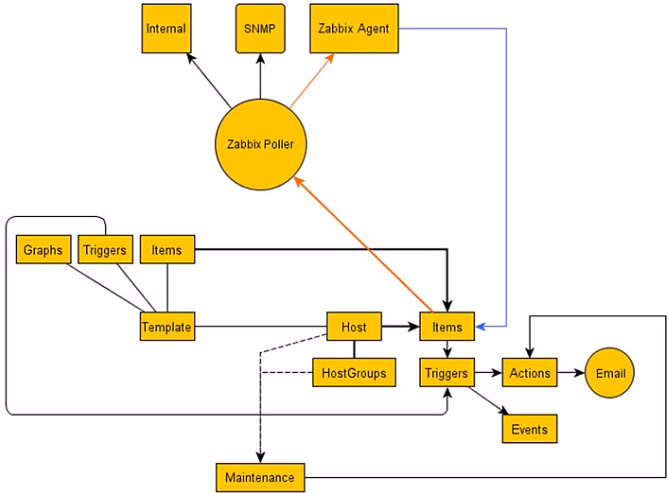自动化运维框架
运维标准流程监控管理容量管理、关联关系、任务管理、自动部署、分布式集群、传统集群、机器管理安全控制灾难管理 自动化监控
监控评估
数据采集主动式数据采集: client、公共插件、自定义脚本被动式服务状态: 服务状态、程序状态、用户访问质量第三方信息 公司内相关系统
数据处理复杂计算阈值判断智能分析
报警与联动报警策略联动处理报警跟踪问题管理
API
通常监控方式
通过snmp监控(nms/agent)
v1、v2明文传输,不安全(非敏感文件),v3认证也很薄弱(目前不流行)通过snmp get 、get-next、get-bulk等采集数据。但是如何存储这些数据?如使用snmptrap实现主动监控,风险很大有些不支持安装agent的需要用到,最优是安装agent,都没的话ssh方式Catci(php开发)工具能帮助 1、采集数据 (依赖snmp,不需要客户端安装agent,本身不是监控工具) 2、保存数据 3、展示数据 4、数据分析及告警。但是告警功能一般。也可以使用rrd轮转数据库,rrd绘图,rrdtool也是个强大的工具(通过插件也能实现告警)Nagios(强大报警工具,也是独立的监控功能)加强告警功能(阈值),是个强大的告警工具,实现告警状态切换功能(邮件,msn,短信)不适合分析展示数据,趋势分析。 能分析依赖关系。不保存数据,只关心状态转换。需要额外插件配置保存相关数据。独立的监控工具,在监控端安装agent也可实现很好的监控主动监控。节点数大于200多,估计要延时Agent+控制端架构 实现可靠监控,管理功能更加强大(路由器没法装哦)上述2种都是不适合大规模监控,一般结合使用Zabbix可以说是nagios和cacti整合,自动发现监控设备 支持分布式监控。为中小规模提供完整的解决方案
monitoring with snmp --> network device
monitoring with zabbix agent --> servers with zabbix agent
monitoring with ping or port check --> servers without zabbix agent
支持的平台
solaris、mac、windows、hp-ux、freebsd、unix、openbsd
ssh脚本(需要账号)
监控系统(MS)的功能
Data gatheringData storage VisualisationAlerting
zabbix的监控功能
zabbix agent cpu/mem/network/disk/service/log/file/other(win性能计数器) snmp agent ipmi agent agentless monitoring web monitoring response time/download speed/response code/content/web scenarios/https and http database monitoring internal check calculated monitoring custom cammand monitoring
支持的通知方法手段
email
sms
jabber
chat message
command execution
zabbix架构
zabbix web gui zabbix database zabbix server (zabbix proxy)-->web pages-->icmp/ipmi/snmp:device-->agent:os
逻辑架构

zabbix常用术语
host主机: 要监控的网络设备,可由IP或DNS名称指定
hostgroup主机组: 主机的逻辑容器
item监控项: 进行数据收集的核心,每个item都由“key”进行标识
trigger触发器: 一个表达式,用于评估监控对象的某特定item内所接收到的数据是否在合理范围内
event事件: 即发生的一个值得关注的事情,例如状态改变,新agent或从新上线的agent的自动注册等
action动作: 对于特定事件事先定义的处理方法,通过包含操作和条件
escalation报警升级
media媒介
notification通知: 通过选定的媒介向用户发送的有关事件的信息
remote command
template 通常包含item trigger graph screen等
applicaton: 一组item的集合
web scennario: 用于检测web站点可用性的一个或多个HTTP请求
监控步骤,定义一次完整的监控
1、确定zabbix监控对象,即添加主机节点 手动添加/自动发现 host-->组成hostgroup 2、定义item(item key) item-->组成application,多台主机监控同一指标时,定义成模板 3、定义grahp --->组成screen 展示,graph自定义整合成graph等 4、trigger定义阈值 -->产生event(discovery也产生event) 定义数据指标(依赖关系,zabbix仅运行在triger上定义依赖关系,nagios可以主机级别) 5、actions (action condition operations(sms/remote command) )
zabbix3.2通过模板监控mysql
1、zabbix-GUI链接Template App MySQL模板
2、zabbix-agent端zabbix_agentd.conf 加入UserParameter后重启zabbix-agent
UserParameter=mysql.status[*],/usr/local/mysql/bin/mysql -uroot -prootabcd -h127.0.0.1 -e "show global status" | awk '/$1\>/ {print $$2}'
UserParameter=mysql.ping,/usr/local/mysql/bin/mysqladmin -uroot -prootabcd -h 127.0.0.1 ping | grep -c alive
UserParameter=mysql.version,/usr/local/mysql/bin/mysql -V
zabbix3.2监控nginx status
1、开启nginx status
location /status {stub_status on;access_log off;allow 127.0.0.1;allow 192.168.0.80; deny all; } | # curl http://192.168.0.80/status |
| Active connections:对后端发起的活动连接数,即正在处理的活动连接数 在访问效率很高,请求很快被处理完毕的情况下,Waiting 数比较多是正常的。如果 reading + writing 数较多,则说明并发访问量很大,正在处理过程中 | |
2、zabbix-agent端zabbix_agentd.conf 加入UserParameter后重启zabbix-agent
UserParameter=Nginx.active[*],/usr/bin/curl -s "http://$1:$2/status" | awk '/^Active/ {print $NF}'
UserParameter=Nginx.accepts[*],/usr/bin/curl -s "http://$1:$2/status" | awk 'NR==3 {print $$1}'
UserParameter=Nginx.handled[*],/usr/bin/curl -s "http://$1:$2/status" | awk 'NR==3 {print $$2}'
UserParameter=Nginx.requests[*],/usr/bin/curl -s "http://$1:$2/status" | awk 'NR==3 {print $$3}'
UserParameter=Nginx.reading[*],/usr/bin/curl -s "http://$1:$2/status" | grep 'Reading' | cut -d " " -f2
UserParameter=Nginx.writing[*],/usr/bin/curl -s "http://$1:$2/status" | grep 'Writing' | cut -d " " -f4
UserParameter=Nginx.waiting[*],/usr/bin/curl -s "http://$1:$2/status" | grep 'Waiting' | cut -d " " -f6
3、在主机节点上添加item(示例)
Name: Nginx.active
Key: Nginx.active[{HOST.IP},80]
Applications:Nginx Status
zabbix agent 类型所有 key
| log[file,<regexp>,<encoding>,<maxlines>,<mode>,<output>] 监控日志文件 | ||
| logrt[file_pattern,<regexp>,<encoding>,<maxlines>,<mode>,<output>] 监控轮转日志文件 | ||
| net.dns[<ip>,zone,<type>,<timeout>,<count>] 检测DNS服务是否开启 | ||
| net.dns.record[<ip>,zone,<type>,<timeout>,<count>] 获取DNS查询数据 | ||
| net.if.collisions[if] Out-of-window collision | ||
| net.if.discovery 列出网卡,通常用于低级别的discovery | ||
| net.if.in[if,<mode>] 统计网卡进流量 | ||
| net.if.out[if,<mode>] 统计网卡出流量 | ||
| net.if.total[if,<mode>] 统计网卡进出流量和 | ||
| net.tcp.listen[port] 检测端口是否可用 | ||
| net.tcp.port[<ip>,port] 检测TCP端口是否可用 | ||
| net.tcp.service[service,<ip>,<port>] 检测服务是否开启,端口是否可用 | ||
| net.tcp.service.perf[service,<ip>,<port>] 检测服务性能 | ||
| net.udp.listen[port] 检测UDP端口是否可用 | ||
| proc.mem[<name>,<user>,<mode>,<cmdline>] 用户进程内存消耗 | ||
| proc.num[<name>,<user>,<state>,<cmdline>] 某用户某些状态的进程数量 | ||
| sensor[device,sensor,<mode>] 读取硬件传感器 | ||
| system.boottime 系统启动的时间戳 | ||
| system.cpu.intr 设备中断数 | ||
| system.cpu.load[<cpu>,<mode>] CPU负载 | ||
| system.cpu.num[<type>] CPU数量 | ||
| system.cpu.switches CPU上下文切换次数 | ||
| system.cpu.util[<cpu>,<type>,<mode>] CPU使用率 | ||
| system.hostname[<type>] 返回主机名 | ||
| system.hw.chassis[<info>] 返回机架信息 | ||
| system.hw.cpu[<cpu>,<info>] 返回CPU信息 | ||
| system.hw.devices[<type>] 列出PCI或者USB | ||
| system.hw.macaddr[<interface>,<format>] 列出MAC地址 | ||
| system.localtime[<type>] 系统时间 | ||
| system.run[command,<mode>] 在指定的主机上运行命令(EnableRemoteCommands=1 ) | ||
| system.stat[resource,<type>] 虚拟内存状态 | ||
| system.sw.arch 返回软件信息 | ||
| system.sw.os[<info>] 返回系统信息 | ||
| system.sw.packages[<package>,<manager>,<format>] 已安装软件列表 | ||
| system.swap.in[<device>,<type>] 磁盘到内存 | ||
| system.swap.out[<device>,<type>] 内存到磁盘 | ||
| system.swap.size[<device>,<type>] 交换分区大小 | ||
| system.uname 返回主机相应信息 | ||
| system.uptime 系统运行时常(s) | ||
| system.users.num 登陆用户数 | ||
| vfs.dev.read[<device>,<type>,<mode>] 磁盘读取状态 | ||
| vfs.dev.write[<device>,<type>,<mode>] 磁盘写入状态 | ||
| vfs.file.cksum[file] 计算文件校验 | ||
| vfs.file.contents[file,<encoding>] 获取文件内容 | ||
| vfs.file.exists[file] 检测文件是否存在 | ||
| vfs.file.md5sum[file] 文件MD5校验码 | ||
| vfs.file.regexp[file,regexp,<encoding>,<start line>,<end line>,<output>] 文件中搜索字符串,返回行 | ||
| vfs.file.regmatch[file,regexp,<encoding>,<start line>,<end line>] 文件中搜索字符串,1找到,0未找到 | ||
| vfs.file.size[file 文件大小 | ||
| vfs.fs.discovery 列出挂载的文件系统 | ||
| vfs.fs.inode[fs,<mode>] 文件系统inode数量 | ||
| vfs.fs.size[fs,<mode>] 文件系统空间 | ||
| vm.memory.size[<mode>] 内存大小 | ||
| web.page.get[host,<path>,<port>] 获取网页内容 | ||
| web.page.perf[host,<path>,<port>] 获取完全加载网页耗时 | ||
| web.page.regexp[host,<path>,<port>,<regexp>,<length>,<output>] 在网页中搜索字符串 | ||
| vfs.file.time[file,<mode>] 文件时间 | ||
zabbix Simple checks 基本检测
zabbix Simple checks 基本检测 Simple checks 通常用来检查远程未安装代理或者客户端的服务。使用 simple checks,被监控客户端无需安装 zabbix agent 客户端,zabbix server 直接使用 simple checks 来收据数据,一基本上都是用来检测远程服务器某端口是否在 监听#yum install fping #grep FpingLocation /usr/local/zabbix/etc/zabbix_server.conf FpingLocation=/usr/sbin/fping # chown root:zabbix /usr/sbin/fping # chmod 4710 /usr/sbin/fping
| icmpping[<target>,<packets>,<interval>,<size>,<timeout>] 检测是否支持icmpping | |
| icmppingloss[<target>,<packets>,<interval>,<size>,<timeout>] 返回丢包率 | |
| icmppingsec[<target>,<packets>,<interval>,<size>,<timeout>,<mode>] 返回响应时间 | |
| net.tcp.service[service,<ip>,<port>] 检测服务是否运行并且接受tcp连接 | |
| net.tcp.service.perf[service,<ip>,<port>] 检测服务性能 | |
)











)

![bzoj4484[JSOI2015]最小表示](http://pic.xiahunao.cn/bzoj4484[JSOI2015]最小表示)




